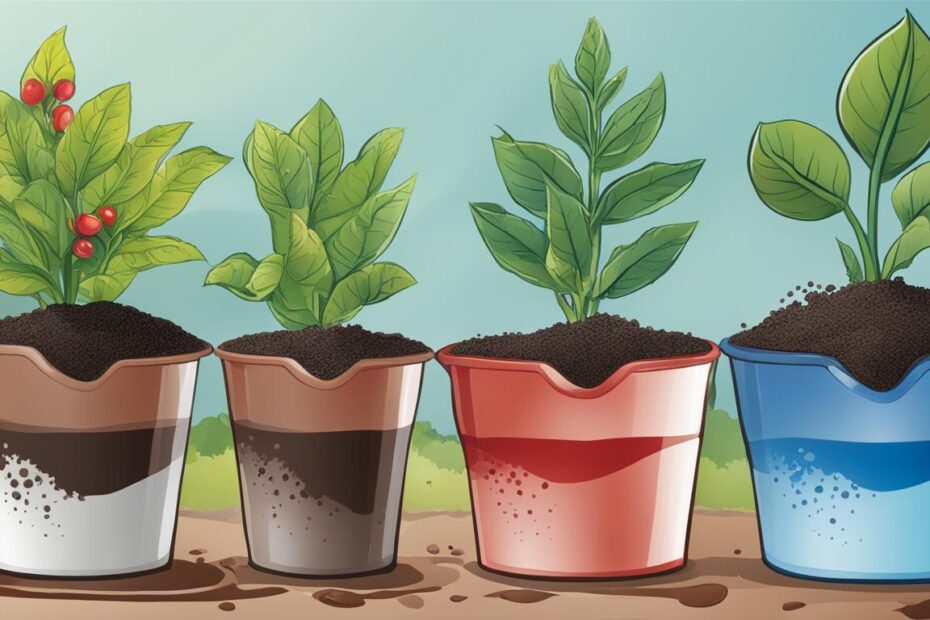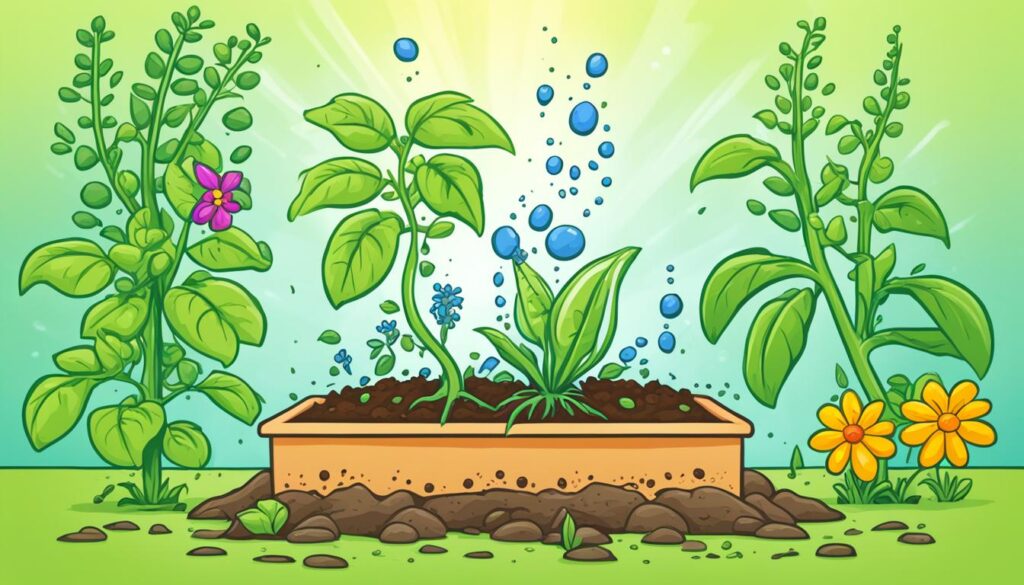Have you ever wondered why some plants thrive while others struggle to grow? The secret may lie in the pH of the potting soil. But what exactly is pH, and how does it impact plant growth?
pH is a measure of the acidity or alkalinity of a material, and it ranges from 0 to 14. In the world of gardening, the pH of potting soil plays a crucial role in determining the success of your plants. But why does pH matter? And what can you do to ensure your plants receive the ideal pH level?
Key Takeaways:
- Soil pH is a crucial factor in determining plant growth and health.
- A pH below 7 indicates acidic soil, while a pH above 7 indicates alkaline soil.
- High pH soils can lead to reduced nutrient availability.
- Measuring soil pH can be done through commercial testing or using inexpensive soil pH test kits.
- Selecting plants that tolerate high soil pH conditions is important for optimal growth.
Understanding Soil pH and its Effects on Plant Health
When it comes to the health and vitality of your plants, soil pH is a critical factor to consider. The pH level of your soil plays a significant role in nutrient availability, directly impacting the overall health and growth of your plants. Understanding soil pH and its effects is essential for successful gardening.
Soil pH is a measure of how acidic or alkaline your soil is, ranging from 0 to 14 on the pH scale. A pH value below 7 indicates acidic soil, while a value above 7 indicates alkaline soil. The ideal pH range for most garden and landscape plants is between 6.0 and 7.2. However, some plants can tolerate slightly higher pH levels, particularly those adapted to arid environments.
In Utah and other parts of the Western U.S., alkaline soils are prevalent, containing high levels of naturally-occurring lime. As a result, it can be challenging to lower the pH of these soils. High pH soils, above 7.2, can lead to reduced availability of essential nutrients, such as iron. Nutrient deficiencies can severely impact plant health and growth.
To ensure plant health in high soil pH conditions, it is crucial to select plants that are tolerant of alkaline soils. By choosing pH-tolerant varieties, you can optimize the success of your garden and minimize the risk of nutrient deficiencies. It’s essential to consider the specific pH requirements of different plant species to make informed choices for successful plantings.
Measuring soil pH is a straightforward process that can be done using soil testing kits or through laboratory analysis. These methods provide accurate readings of soil pH, enabling you to make informed decisions about soil amendments and plant selection.
Now, let’s take a closer look at the effects of soil pH on plant health and the availability of nutrients.
The Impact of Soil pH on Nutrient Availability
Soil pH directly influences nutrient availability to plants. Different nutrients have varying solubility and accessibility at different pH levels. While most essential nutrients are readily available to plants within the optimal pH range of 6.0 to 7.2, certain nutrients may become limited or less accessible at higher or lower pH levels.
High pH soils, above 7.2, tend to have reduced availability of essential nutrients like iron, zinc, copper, and manganese. These nutrients, known as micronutrients, are necessary for various plant functions, including chlorophyll synthesis, enzyme activities, and overall plant growth. Nutrient deficiencies can manifest as yellowing leaves, stunted growth, and reduced flowering or fruiting.
On the other hand, acidic soils with pH values below 6.0 can lead to increased availability of certain nutrients, such as iron, but limited availability of others. Excessive acidity can also be detrimental to plant health, as it can disrupt microbial activity in the soil and impact nutrient cycling.
By maintaining an optimal soil pH range for your plants, you can ensure that essential nutrients are readily available and facilitate optimal plant growth and development.
Choosing pH-Tolerant Plants for High pH Soils
When dealing with high pH soils, it’s crucial to select plants that are well-suited for alkaline conditions. These pH-tolerant plants have adapted mechanisms to thrive in soil with limited nutrient availability.
A variety of vegetables, flowers, and shrubs are suitable for growing in alkaline soils with pH levels ranging from 7.0 to 8.0. By choosing pH-tolerant plant varieties, you can enjoy a beautiful and productive garden, even in challenging soil conditions.
| Plant | Optimal pH Range |
|---|---|
| Tomatoes | 6.0-7.5 |
| Peppers | 5.5-7.0 |
| Lavender | 6.4-8.2 |
| Roses | 5.5-7.0 |
Table: pH-tolerant plants for high pH soils
By selecting pH-tolerant plants and regularly monitoring and adjusting your soil pH, you can create a thriving garden, even in high pH conditions. Maintaining optimal pH levels ensures that your plants have access to the nutrients they need for vigorous growth and vibrant blooms.
Next, we’ll explore different methods for measuring and adjusting soil pH to create the ideal growing conditions for your plants.
CLICK HERE TO CHECK OUR RECOMMENDED PRODUCTSMeasuring and Adjusting Soil pH
Measuring soil pH is crucial in determining the acidity or alkalinity of your potting soil. By understanding the pH level, you can ensure optimal conditions for your plants to thrive. There are two primary methods for measuring soil pH: commercial testing laboratories and home soil pH test kits.
Commercial testing laboratories analyze soil samples to provide accurate and comprehensive pH measurements. To collect a sample, you can reach out to your local county Extension office, as they often facilitate the process of submitting samples for laboratory analysis.
If you prefer a more convenient and cost-effective approach, home soil pH test kits are readily available at home and garden stores. These kits provide a quick estimate of soil pH, allowing you to monitor the conditions of your potting soil regularly.
If your soil pH needs adjustment, there are several effective methods you can employ:
- Adding organic matter: Incorporating organic matter, such as peat moss, into the soil can help lower pH levels over time. It improves soil structure and acts as an acidifying agent.
- Utilizing elemental sulfur: Gradually lowering soil pH can be achieved by adding elemental sulfur. This material releases sulfur compounds that acidify the soil over an extended period.
- Using acidifying fertilizers: Acidic fertilizers, like ammonium sulfate, can lower soil pH and provide essential nutrients for plant growth. Regular application can help maintain the desired pH range.
All pH- adjusting methods should be implemented cautiously and in moderation, ensuring that the changes occur gradually rather than causing sudden pH fluctuations.
Regularly monitoring soil pH is essential to maintain optimal conditions for your plants. Aim to keep your soil pH within the recommended range for each specific plant’s needs.
With accurate pH measurements and the appropriate adjustments, you can create an ideal environment for your plants to flourish.
| Plant Name | Optimal pH Range |
|---|---|
| Roses (Rosa spp.) | 5.5-7.0 |
| Tomatoes (Solanum lycopersicum) | 6.0-6.8 |
| Azaleas (Rhododendron spp.) | 4.5-6.0 |
| Blueberries (Vaccinium spp.) | 4.0-5.0 |
| Hydrangeas (Hydrangea spp.) | 5.2-6.2 |
| Lawn Grass (Warm-season) | 6.0-7.0 |
Living with High pH Soils
Living with high pH soils can present challenges for gardeners, but it doesn’t have to hinder your gardening success. Instead of trying to lower the pH of your soil, an often complicated and costly process, you can embrace the characteristics of alkaline soils and select plants that are well-suited to these conditions.
Alkaline soils, commonly found in the Western U.S., including Utah, contain naturally occurring lime that buffers the pH in the alkaline range. These soils typically have a pH above 7, making it difficult to lower the pH to the ideal range for most plants.
However, many plants have adapted to thrive in slightly alkaline soils with a pH range of 7.0 to 8.0. By selecting pH-tolerant plants, you can create a beautiful garden that can flourish even in high pH soils.
Benefits of selecting pH-tolerant plants:
- Maximize your gardening success: pH-tolerant plants are more likely to thrive in the conditions of high pH soils, resulting in healthier and more vibrant plants.
- Reduce nutrient deficiencies: Plants grown in high pH soils may experience reduced nutrient availability, especially for micronutrients like iron. By choosing plants that can withstand these conditions, you can minimize the risk of nutrient deficiencies and promote lush growth.
- Simplify your gardening efforts: Instead of struggling to manipulate soil pH, selecting pH-tolerant plants allows you to work with the existing conditions of your soil, saving you time and effort.
To help you choose the right plants for your garden, refer to Table 1 below, which provides a list of common garden plants and their optimal pH ranges:
| Plant | Optimal pH Range |
|---|---|
| Roses | 6.0-7.5 |
| Lavender | 6.0-8.0 |
| Tomatoes | 6.0-7.5 |
| Zinnias | 5.5-7.5 |
By selecting plants that fall within the optimal pH range for your soil, you can create a thriving garden that defies the limitations of high pH soils. Remember to consider other factors such as sunlight requirements, water needs, and climate suitability when choosing plants for your garden.

With the right selection of pH-tolerant plants, you can transform your high pH soil into a flourishing garden that brings you joy and beauty. Embrace the unique characteristics of your soil and create a garden that showcases the resilience and adaptability of nature.
CLICK HERE TO CHECK OUR RECOMMENDED PRODUCTSLowering Soil pH
If your soil pH needs to be lowered, there are several effective methods you can consider. By incorporating certain soil amendments and utilizing acidifying fertilizers, you can gradually adjust the pH level to create more suitable conditions for your plants.
One popular method is to add organic matter, such as peat moss, to your soil. Peat moss has natural acidifying properties that can help lower pH levels over time. Simply mix it into the soil and allow it to work its magic.
Another option is to use elemental sulfur, available in 90 or 99% sulfur material. Adding elemental sulfur at a recommended rate of 6 to 10 pounds per 1000 square feet of area can promote a gradual acidification process. It’s important to apply the sulfur evenly across your garden to ensure a consistent pH adjustment.
Acidifying fertilizers, such as ammonium sulfate, can also be utilized to lower the soil pH. These fertilizers contain nitrogen in the form of ammonium, which aids in acidification. Follow the manufacturer’s instructions for application rates and frequency.
However, it’s crucial to monitor your soil pH regularly to ensure it stays within the desired range. Conduct soil tests periodically and adjust your soil amendments or fertilizers accordingly. It’s worth noting that lowering soil pH may require multiple applications over time to achieve the desired pH level, so be patient and diligent in your efforts.
To summarize, here are the methods for lowering soil pH:
- Add organic matter, such as peat moss
- Use elemental sulfur
- Apply acidifying fertilizers, like ammonium sulfate
By implementing these techniques and consistently monitoring your soil pH, you can create a more acidic environment that promotes optimal plant growth and cultivates thriving gardens.
The Impact of pH on Microbial Life in Soil
The pH of the soil has a profound effect on the delicate balance of microbial life within it. In every handful of healthy soil, there exists a bustling community of microorganisms, including bacteria, fungi, and protozoa. These microscopic organisms play a vital role in maintaining soil health and facilitating the nutrient cycling process.
The soil’s pH level directly influences the composition and diversity of these microbial communities. Some microorganisms thrive in acidic environments, while others prefer alkaline conditions. The pH of the soil also affects the availability of essential nutrients for both the microorganisms and the plants they support. Consequently, soil pH has a direct impact on the activity and functioning of the soil microbiome, which is essential for overall soil health and plant growth.
To ensure the flourishing of the soil microbiome and promote optimal soil health, it is crucial to maintain a balanced pH range. This will support a diverse microbial community and a harmonious interplay between the microorganisms and the surrounding environment. By creating these favorable conditions, gardeners can harness the full potential of their soil and foster thriving plant life.
The Role of pH in Nutrient Availability
The pH of the soil directly affects the availability and accessibility of nutrients for plants and microorganisms. Each nutrient has an ideal pH range in which it can be efficiently absorbed by plant roots. Deviations from this optimal pH range can result in nutrient deficiencies or toxicities, hindering plant growth and development.
In acidic soils, certain nutrients, such as iron, manganese, and zinc, become more readily available to plants. Conversely, alkaline soils can limit the availability of these essential micronutrients. Therefore, maintaining a suitable pH level is crucial to ensure the adequate supply of nutrients to plants and the microorganisms that rely on them.
Creating a Balanced pH for a Healthy Soil Microbiome
There are several strategies to maintain a balanced pH for a thriving microbial community and a healthy soil ecosystem:
- Regular soil testing: Periodic soil testing helps monitor the pH level and identify any necessary adjustments.
- Choose pH-adapted plants: Select plant varieties that are well-suited to the soil’s natural pH range, reducing the need for drastic pH adjustments.
- Add organic matter: Incorporate compost, leaf mold, or other organic materials into the soil to improve its structure and buffer pH fluctuations.
- Acidifying amendments: Use sulfur-based products or acidifying fertilizers to gradually lower the soil pH if necessary.
By following these practices, gardeners can create a balanced pH environment that promotes abundant microbial life and unlocks the full potential of their soil for improved plant health and vigor.
The pH of the soil directly impacts the microbial communities that reside within it, affecting their composition, diversity, and activity. By maintaining a balanced pH range, gardeners can cultivate a healthy soil microbiome that supports optimal soil health and plant growth.
CLICK HERE TO CHECK OUR RECOMMENDED PRODUCTSConclusion
Mastering the pH of potting soil is crucial for achieving optimal plant growth. The pH level of the soil directly affects the availability of nutrients and plays a significant role in plant health. It also influences the composition and diversity of microbial communities in the soil, which are vital for nutrient cycling and overall soil health.
To ensure successful gardening and minimize nutrient deficiencies, it is important to understand the pH requirements of different plants and select varieties that are tolerant of specific pH levels. Regular soil testing and pH monitoring are essential for maintaining the ideal conditions for plant growth.
Fortunately, adjusting soil pH is possible with the implementation of appropriate soil amendments. Adding organic matter, such as peat moss, can help lower the pH of alkaline soils over time. Acidifying fertilizers and elemental sulfur are also effective in gradually reducing soil pH. By making these adjustments, gardeners can create the optimal pH conditions for their plants.
By mastering the pH of potting soil, you can unlock the full potential of your plants. With the right pH levels, your plants will have improved nutrient uptake, enhanced growth, and vibrant blooms. So take the time to understand and monitor the pH of your soil, make the necessary adjustments, and watch your garden flourish with lush, healthy plants.
FAQ
What is soil pH and why is it important for plant growth?
Soil pH is a measure of the acidity or alkalinity of the soil. It affects the availability of nutrients to plants and can impact their overall health and growth.
How can I measure the pH of my potting soil?
You can measure soil pH using commercial testing laboratories or using inexpensive soil pH test kits available at home and garden stores.
What is the optimal pH range for most garden plants?
A soil pH of 6.0 to 7.2 is considered optimal for the growth of most garden plants. However, some plants can tolerate slightly alkaline soils with a pH range of 7 to 8.
What should I do if my soil pH is too high?
If your soil pH is too high, you can lower it by adding organic matter, such as peat moss, or using acidifying fertilizers. It may take multiple applications over time to achieve the desired pH level.
Can I grow plants in high pH soils?
Yes, many plants can tolerate high pH soils. By selecting pH-tolerant plants, you can still have successful plantings in alkaline soils.
How does soil pH affect microbial life in the soil?
Soil pH can influence the composition and diversity of microbial communities in the soil. It is important to maintain a balanced pH range to promote a healthy and diverse soil microbiome.
Why is mastering the pH of potting soil important?
Mastering the pH of potting soil is crucial for achieving optimal plant growth. It ensures nutrient availability, plant health, and a thriving soil microbiome.

